

Facts about Dadaism. Dadaism began in Zurich, Switzerland during the First World War.
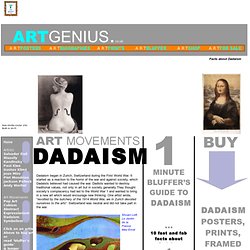
It started as a reaction to the horror of the war and against society, which Dadaists believed had caused the war. Dadists wanted to destroy traditional values, not only in art but in society generally.They thought society’s complacency had led to the World War 1 and wanted to bring in a new art which would encourage new thinking. Dada and Art History. Introduction to the Artistic Style of Dada By ArtHistory.net While viewed by some as reactionary to World War I, Dada really involved creative intellectuals doubling as nihilistic revolutionaries.

On a war-scarred continent, where else does one find the irresistible combination of culture, romance, anarchism, and intrigue? In the translator’s introduction to Francis Picabia’s “I Am a Beautiful Monster: Poetry, Prose, and Provocation,” Marc Lowenthal explains: “Dada is the groundwork to abstract art and sound poetry, a starting point for performance art, a prelude to postmodernism, an influence on pop art, a celebration of anti-art to be later embraced for anarcho-political uses in the 1960s and the movement that lay the foundation for Surrealism.” At first glance, this small movement could hardly have caused such waves in aesthetic expression. The Dada experience was profound enough for some intellectuals that it continued to influence their work for more than fifty years. Dada - Art History Basics on the Dada Movement - 1916-1923. Dada was, officially, not a movement, its artists not artists and its art not art.

That sounds easy enough, doesn't it? Of course, there is a bit more to the story of Dadaism than this simplistic explanation. Dada was a literary and artistic movement born in Europe at a time when the horror of World War I was being played out in what amounted to citizens' front yards. Due to the war, a number of artists, writers and intellectuals -- notably of French and German nationality -- found themselves congregating in the refuge that Zurich (in neutral Switzerland) offered. Far from merely feeling relief at their respective escapes, this bunch was pretty ticked off that modern European society would allow the war to have happened. Banding together in a loosely-knit group, these writers and artists used any public forum they could find to (metaphorically) spit on nationalism, rationalism, materialism and any other -ism which they felt had contributed to a senseless war.
Dada - The Anti-War Art Movement. DADAThe Art History Archive - Art Movements Toronto Website Design & Toronto SEO The Anti-War Art Movement Right: Hannah Hoch - Cut with the Kitchen Knife Through the First Epoch of the Weimar Beer-Belly Culture, 1919.

The piece on the right by Hannah Hoch epitomizes the Dada attitude towards war: That it is chaos. That the world has gone mad. Dada was many things, but it was essentially an anti-war movement in Europe and New York from 1915 to 1923. The most widely accepted account of the movement's naming concerns a meeting held in 1916 at Hugo Ball's Cabaret (Café) Voltaire in Zürich, during which a paper knife inserted into a French-German dictionary pointed to the word "dada". Dada - a short history. European dadaism. Dada and dadaism : Berlin. Germany Dada: An Alphabet of German Dadaism Parts 1 & 2 - 1969.
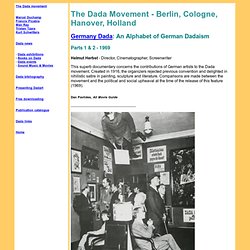
Cabaret Voltaire. World War I and Dada. What is Dadaism and Dada Movement in Europe. The early futurists too experimented with typography ushering in a new but more intense and expressive communication that was a synthesis of literary and graphic.
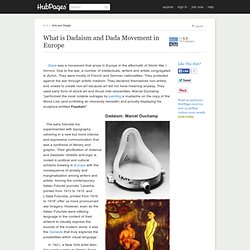
Their glorification of violence and Dadaists’ nihilistic anti-logic is rooted in political and cultural schisms brewing in Europe with the consequence of anxiety and marginalization among writers and artists. Among the contemporary Italian Futurist journals “Lacerba, printed from 1913 to 1915, and L’Italia Futurista, printed from 1916 to 1918” offer us more pronounced war imagery. Magazine - A Critical History of 20th-Century Art.
By Donald Kuspit Chapter 2, Part 1Spiritualism And Nihilism: The Second Decade A general interest in abstraction is being reborn, both in the superficial form of the movement towards the spiritual, and in the forms of occultism, spiritualism, monism, the "new" Christianity, theosophy and religion in the broadest sense....
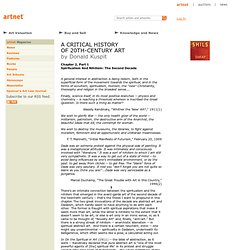
Finally, science itself, in its most positive branches -- physics and chemistry – is reaching a threshold whereon is inscribed the Great Question: Is there such a thing as matter? Wassily Kandinsky, "Whither the ‘New’ Art? ," 1911(1) John Heartfield: Dada. Art Movements for the Non-Arts Student: Dada. So Futurism looked to the future.
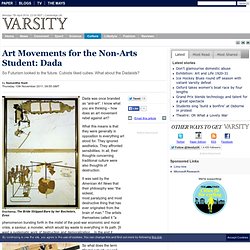
Cubists liked cubes. What about the Dadaists? By Samantha Hunt Thursday 10th November 2011, 09:55 GMT Duchamp, The Bride Stripped Bare by her Bachelors, Even. Dada - Dadaism Art. Dadaism (1916-1924) Dadaism or Dada is a post-World War I cultural movement in visual art as well as literature (mainly poetry), theatre and graphic design.

Dada. Dada. In 1916, during World War I, an international movement arose that declared itself against art. Responding to the absurdity of war and the insanity of a world that gave rise to it, the Dadaists declared that art--a reflection of this sorry state of affairs--was stupid and must be destroyed. Yet in order to communicate their outrage, the Dadaists created works of Art ! This inherent contradiction spelled the eventual demise of their movement. For all its bravado, Dada ended with a whimper in 1922. In an effort to advertise their nihilistic views, the Dadaists assaulted the public with irreverence. Later he summed up the dada sensibility in works such as MONA LISA in which he defiled a color print of DaVinci's masterpiece with a mustache and goatee and the letters L.H.O.O.Q. which in french means "She's Got a Hot Ass"... referring da Vinci's supposed homosexuality.
DaDa in Germany took on a stronger political edge. In Grosz's Germany, everything and everybody is for sale. * Dada - (Fine arts): Definition. Dada. International Dada Archive.